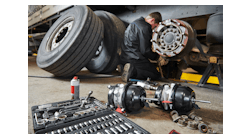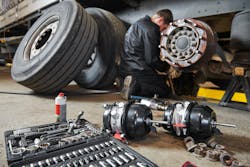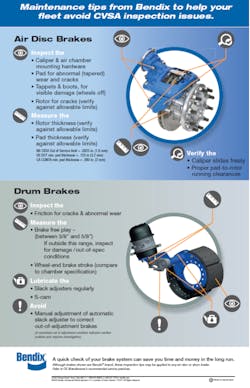Fleet owners, managers, and technicians should take brake safety seriously. According to Arnold and Itken Trial Lawyers, fully loaded semi-trucks running at 55 miles per hour take up to 200 ft. to come to a complete stop versus passenger cars, which take only 135 ft. to reach a complete stop when traveling at the same speed. If a truck's brakes are hot from heavy use by the driver, that stopping distance can be up to 450 ft. That extra distance could make the difference between life and death in the event of an accident.
To ensure safety and to promote an environment where fleet drivers and technicians keep truck brakes maintained, the Commercial Vehicle Safety Alliance holds an annual brake safety event called Brake Safety Week. The inspection blitz began Aug. 20 and runs through Saturday, Aug. 26. Specifically, inspectors will focus on brake linings and pads during their typical inspections, removing those with brake-related out-of-service violations until they are corrected, and then publishing a release with their inspection findings in the fall.
See also: Brake check-in: The latest on heavy-duty truck braking systems
During 2022's Brake Safety Week, CVSA-certified inspectors checked 38,117 vehicles between the U.S., Canada, and Mexico, and placed 34,402 vehicles out of service in the U.S. alone. CVSA also runs International Roadcheck in May. The group removed 19% of trucks and 5.5% of drivers between May 16 and May 18 due to out-of-service violations. During Brake Safety Week this year, inspectors will pay special attention to brake pads that are contaminated, worn, or cracked or vehicles that are missing linings or pads altogether.
To avoid violations and expensive downtime, there are several ways technicians and drivers can work together to keep vehicles on the road, from taking extra care during pre- and post-trip inspections to cultivating efficient driving practices.
How drivers can prepare
Jeff Martin, VP of safety and sales at Lytx, a fleet management, safety, and telematics provider, outlined several best practices for drivers to preserve their brakes. Some of these tactics include knowing that a fully-loaded trailer will have less braking capacity than one with less-than-truckload freight and compensating appropriately. Martin also emphasized that drivers should always be aware of the terrain and weather and be proactive in their braking so that less wear and tear is transferred to the components.
One problem to be especially wary of is brake heating, which is when brakes begin to heat up after repeated acceleration and deceleration in a short amount of time. Last-mile delivery vehicles are particularly susceptible to this. If drivers aren't careful, brake heating can severely impact their truck's systems.
See also: Roadcheck 2023 put 19% of trucks, 5.5% of drivers out of service
"That's one of the things that cause trucks and vehicles to experience brake fade, especially when they have heavy weights on their backs," Martin cautioned. But "one of the things [drivers] can do is make sure that their acceleration and speed is within reason for their next braking occurrence."
And, of course, if a driver notices any signs of reduced brake capacity or effectiveness, they must report it to their fleet manager, potentially avoiding an out-of-service violation before they hit the road.
"It could be subtle, or it could be a sudden issue, or it could be an issue that is continuing to get worse," Martin said. "You need to make sure that you're talking about it because if the issue is serious enough and you find it on your pre-trip or post-trip, it could result in having to take another vehicle."
How technicians can prepare
Conversely, technicians should communicate well with drivers.
"A driver out on the road may be the first one to notice an issue with the truck," said Fred Andersky, director of demos, sales, and service training at Bendix Commercial Vehicle Systems. "It's vital that the driver be able to tell the technician what happened, where it happened, and details such as weather conditions. And it's just as vital for the technician to ask questions to gain a clearer understanding of the situation."
For Brake Safety Week, it would behoove techs to pay attention to the same items that inspectors will look for during their pre and post-trip inspections, including:
- Missing, nonfunctioning, loose, or cracked parts
- Holes caused by rust and through rubbing or friction
- Broken springs in the spring brake housing section of the parking brake
- Air leaks around brake components and lines
- Air pressure in the target range of 90-100 psi
- Proper pushrod travel
- Slack adjusters not at the same length
- Mismatched air chamber sizes across axles
- Warning device functionality (such as antilock braking system indicator lights)
- Proper operation of the tractor protection system, including the bleed-back system on the trailer
- The breakaway system being operable on the trailer
Even small items, such as a kink in an air hose or an active full-stability light on the dash, could earn a vehicle extra attention from an inspector, explained Mark Holley, director of marketing and customer solutions, wheel-end, at Bendix, a manufacturer of commercial vehicle brakes and safety systems.
"What you do in the shop and during pre-trip walkarounds—looking at every aspect of your vehicle—can make an important difference on the road and during a brake system inspection, simply by catching brake-related issues before they become problems," Holley said. "Your regular inspections can go a long way toward catching some obvious violations, including loose hoses or damaged components like air chambers or pushrods."
To ensure technicians are staying on top of their brake inspections, Bendix advises that technicians check for certain brake elements daily, weekly, and monthly.
Truck brake checks every day:
- Check for damaged or loose-hanging air chambers, pushrods, or slack adjusters.
- Make sure each axle's slack adjusters are extended to the same angle. Different angles can indicate an out-of-adjustment brake or a broken spring brake power spring.
- Examine tubing and hose condition, positioning, and connections.
Truck brake checks every week:
- Perform a 90 to 100-psi brake application with the wheels chocked and the parking brakes released and listen for leaks.
- Check air disc brake rotors for cracks.
- Inspect drum brake linings for wear and cracks.
Truck brake check every month:
- Check for moisture in the air system to prevent contamination that leads to component deterioration and system leaks
Bendix officials also advised technicians to grease the S-cam brake tubes and automatic slack adjusters whenever a vehicle visits the shop, as this will help prevent rust and corrosion.
Technicians should also be wary when examining pushrod travel, as pushrod stroke that exceeds regulations gradually reduces braking force. However, because of the difference between air disc brakes and drum brakes, measuring the brake stroke on each mechanism takes different processes.
See also: Decoding the disc vs. drum brake debate
"Measuring a drum brake's chamber stroke is a matter of checking the distance from the air chamber to the clevis pin with the brakes released, and then again after a fully charged brake application," Holley explained. "The difference between these measurements is the brake stroke, and its maximum length depends upon the brake chamber type and size."
Bendix officials also advised that technicians take care when replacing critical equipment.
"When it's time to replace a component in your brake system, whether it's at the wheel-end or in the air supply, be sure to select parts that won't degrade the performance level or bring it below the original equipment manufacturer's standards," Holley said. "This selection is particularly true when it comes to brake friction, where the aftermarket is more crowded than ever, and the wrong choice can actually harm your system and your vehicle safety."
When looking for signs of brake friction, Holley said that technicians should look for cracks, braking performance degradation, or wheel-end components' damage.
The company also suggested technicians use an oil-coalescing air dryer cartridge to protect the air supply against corrosive oil aerosols that could lead to leaks and potential violations. However, while oil-coalescing cartridges can replace standard cartridges, Bendix officials warned never to downgrade from an oil-coalescing cartridge to a standard.
By paying attention to driver and technician best practices, fleets should be able to keep their vehicles on the road during 2023's Brake Safety Week.
This article originally appeared on FleetOwner affiliate Fleet Maintenance.





